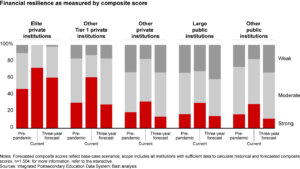Higher education gained an unlikely asset during the pandemic, and it came in the shape of billions of dollars of federal emergency funding. While CARES Act funding largely kept schools afloat and even jumpstarted a renaissance at HBCUs, one global management consulting firm believes most higher ed is unprepared to deal with a post-pandemic landscape.
A new report by Bain & Company is forecasting the majority of higher education to be financially vulnerable three years from now due to a confluence of operational challenges affecting institutions. Some are derived from the pandemic, such as expenses derived from the new trend toward hybrid/virtual learning. Some go deeper, such as shifting student demographics, which Bain has been discussing for the past decade.
Elite and Tier 1 private colleges are the only segments of higher education well-prepared to embark on the following three academic years without significant financial worries. All other private institutions, the report advises, must take substantial actions to shore up finances and increase their program’s value propositions to avoid closure, echoing the conclusion of a similar report by another business consulting firm Ernst & Young. “Colleges and universities will not be propped up by the confluence of factors that enabled them to pull through the pandemic years,” wrote Bain’s authors.
While large public institutions’ three-year forecast doesn’t look strong, Bain concludes they aren’t on the brink of failure due to their ability to diversify revenue streams, public support, cost-cutting options and scale. However, one state college system has already begun raising the alarm about what may be in store in the upcoming academic year post-CARES Act funding.
“We’re about to fall off that cliff,” said Higher Education Co-Chairman Gregg Haddad to CT Insider referring to the reliance the state system placed on one-time federal aid investments.

Cost-cutting is not enough
Despite some special emergency measures taken by institutions, such as Ohio State University, to create a healthy budget surplus in the wake of the pandemic, Bain believes many short-term initiatives were simply band-aids for a deeper problem.
“Despite some deep, temporary cost cuts, most colleges and universities did not fundamentally change their financial foundations during the pandemic,” the report’s five authors wrote. “So as these institutions approach the next set of challenges, they will not be in a stronger position than they were at the start of the pandemic.”
Inflation and interest growth have negated many institutions’ ability to maintain vigorous cost-cutting strategies and increase tuition. For example, colleges must also address increasing student financial aid and decreasing private giving and endowments. Similarly, building an online infrastructure to appease the demands of digitally native students will prove costly.
Bain advises college leaders to innovate and discover long-lasting solutions outside their traditional networks.
“Administrators should take heed, though; the traditional approach of setting up broad committees and subcommittees of legacy administrators and faculty to develop a course of action is unlikely to generate the breakthrough ideas and necessary disruption that is required over the long term. Rather, many institutions will need to look beyond their core ranks for the insights, best practices, and change agents to take stock of their resilience and reset their course into an uncertain future.”







